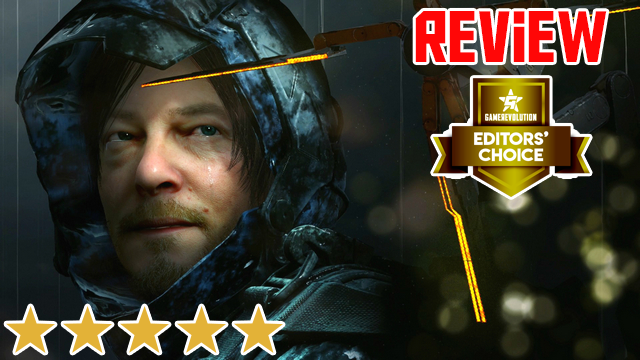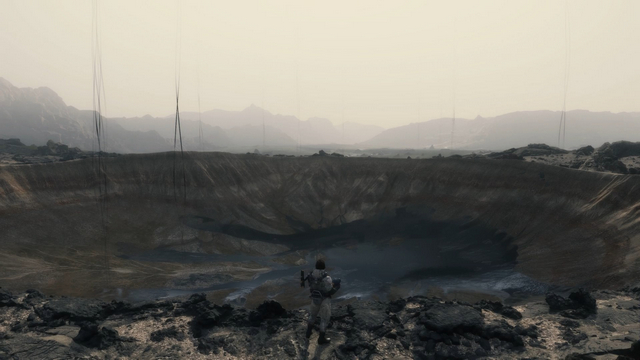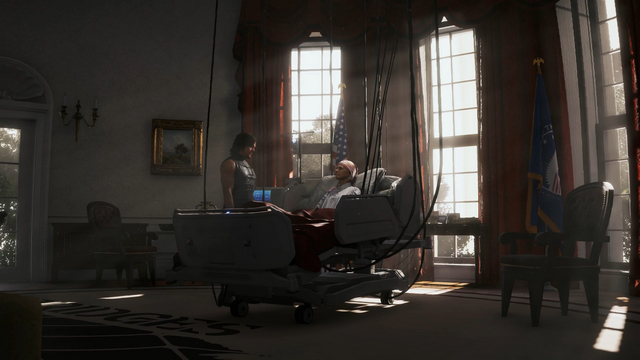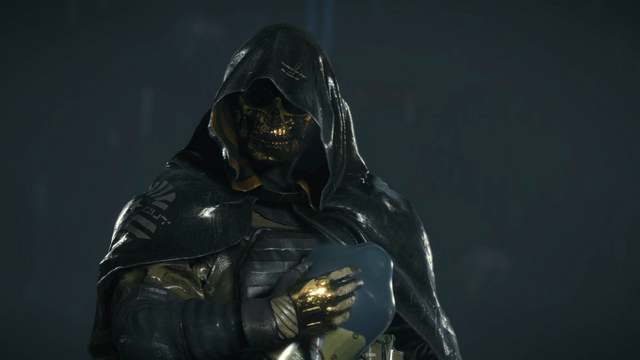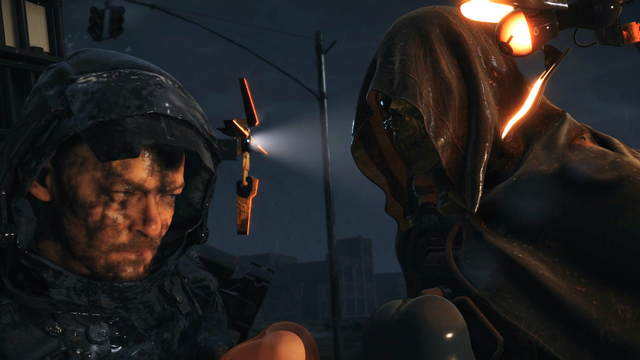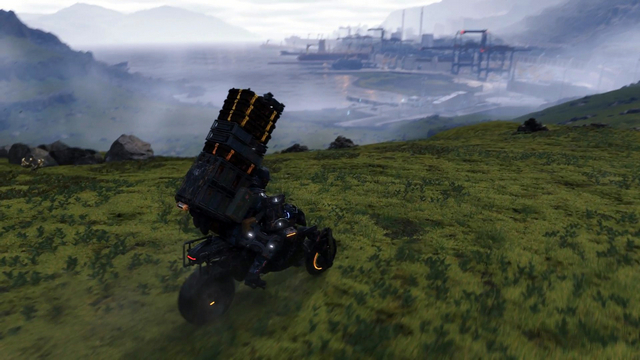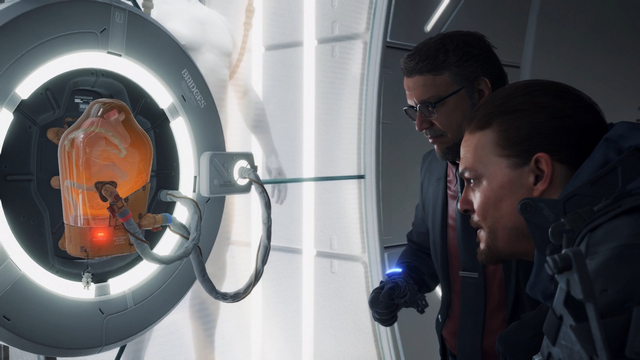Death Stranding is an anomaly in the video game industry. With AAA studios firmly entrenched, we seldom get to see a brand new studio like Kojima Productions get a blockbuster budget, A-list celebrity casting, and the backing of Sony for their first title. Of course, Hideo Kojima isn’t just any developer. He’s been involved in developing some of the most-lauded games in history throughout his 34-year career and is one of the most recognizable personalities in our industry. Death Stranding marks not only the new studio’s first production but also Kojima’s first game post-Konami.
I’m not going to beat around the bush here. Death Stranding is a masterpiece. It melds the best of cinematic and gaming traditions to craft a country-spanning saga in a true epic. This is the pinnacle of gaming, and it feels like every title made before it was leading to Death Stranding. Some critics felt like Konami kept Kojima’s wilder ideas in check and that this game would be a disaster of half-baked concepts. If anything, Death Stranding is Kojima’s most cohesive game to date, and even though it does present a strange and at times, confusing scenario, by the end, everything makes sense. Despite the fantastical setting, its themes are very much grounded in the real world.
Editor’s Note: Our embargo stated we could only cover story elements through Chapter 3 in our review. However, this review reflects our experience with the game in its entirety in general terms.
Death Stranding Review | Story
The Death Stranding is a cataclysmic event that weakened the barrier between the world of the living and the dead. Much of humanity has been wiped out by the appearance of Beached Things (BTs). These creatures are the souls of the dead who have crossed over into our world. In addition to being invisible to a normal person, when a BT consumes a human body, it creates a voidout. These voidouts are a massive explosion that can be large enough to take out entire cities. This constant threat means that many large settlements have been wiped out without any warning. In addition to the danger of BTs, rain has turned into Timefall, which ages anything it touches. The hazards of the outside world mean that the remaining humans must cling to life in the remaining cities and shelters dotted throughout America, disconnected from each other.
There does exist a small percentage of the population who display resistance to Timefall and who can sense the presence of BTs. You play as Sam Porter Bridges (Norman Reedus), one of these individuals. Sam, as his name suggests, is a porter, someone who delivers vital supplies between the remaining vestiges of society. As the nation’s infrastructure has collapsed, porters are essential to the survival of humanity, and Sam, in particular, is already lauded as one of the best when the game begins.
Even though the United States of America has collapsed, some people wish to see the country reborn. Bridges is a company formed by the last President of the United States to reconnect the nation and establish the United Cities of America. Three years before the game begins, the foundations of this endeavor were laid by the first Bridges expedition. This group made it from the east to the west coast before separatists terrorists captured their leader, Amelie (Lindsay Wagner). Due to Sam’s prowess, and his relationship to the former president, he’s asked to complete the work of the first Bridges expedition. His mission is to network the cities and shelters of America to allow the new nation to be born.
Along the way, a Bridge Baby (BB) acts as your partner. While Sam can sense BTs, he can’t see them and requires a connection to a BB to do so. These BBs are suspended between the world of the living and the dead as their mothers are brain dead. The environment in the pod simulates their mother’s womb. This tricks them into staying unborn, preserving the connection to their mother, and allows them to be portable without losing their ability to detect BTs. Sam and BB’s journey will have you learning the mysteries behind the Death Stranding and what it will take to save humankind from extinction.
Death Stranding Review | Objectives
Sam’s overarching mission is to reconnect the splintered remnants of the former United States to form a new country, the United Cities of America. While the land between settlements is still fraught with danger and unclaimable at this time, the smattering of towns and individuals that remain have etched out a place where they can survive. However, to prosper, they need the benefits of the Chiral Network, which allows for the sharing of information at an instantaneous rate. It’s hoped that by uniting these disparate peoples with the network, that humanity can start to reclaim the knowledge they’ve lost as a result of the Death Stranding and prevent the extinction of our race.
What makes Sam perfect for this job, besides having DOOMS and being a repatriate, is that he’s one of the best porters in the business. Since all logistical networks have broken down, all the cargo in the world of Death Stranding has to be shipped by hand. His previous experience means that Sam is already an expert at navigating the hazards of terrain and the threat of BTs. Of those available, he has the best chance of anyone of making it from the east coast to the west, connecting settlements on the way.
Connecting places to the Chiral Network isn’t Sam’s only objective during Death Stranding. Bridges and the UCA have no qualms about putting him to work delivering essential goods as well. You’ll often find yourself carrying vital cargo in the course of the story since not many porters are confident enough to venture very far. As you connect the world and clear hazards, this changes, and you’ll see more of your porter comrades walking about delivering cargo.
Death Stranding Review | Themes
At its core, Death Stranding is about the threads that connect each of us. Each aspect of the game, be it the story, gameplay, or the Social Strand System, calls attention to the ties that bind us and the strength they give us. Kojima has stated the game is about the “rope” instead of the “stick.” It’s revolutionary in that it concentrates less on a traditional protagonist vs. antagonist plot structure and more on the aspects of connectivity and unity.
Throughout the game, Sam’s journey reflects the larger picture. In the beginning, he has separated himself from the remains of society. His attitude and his Aphenphosmphobia (fear of being touched), reflect the world in which he lives. After the failure of the Bridges I expedition, the shattered nation lives in fear of Homo Demens. That terror manifests itself in many people as a reluctance to join the UCA. Through Sam’s hard work, these people start to realize the strength of togetherness, and through them, Sam begins to feel a connection to others as well.
Death Stranding also examines the commoditization of people in the form of the Bridge Babies. In an early conversation with Deadman, we see that even though Bridges is altruistic, they fall into the trappings of seeing BBs as tools, not people. Sam’s growing affection towards his BB is warned off as being too sentimental. When Sam first receives his BB, it’s said to be behaving erratically and that most of them have to be “retired” after a year in service.
The overriding message I took away from Death Stranding is that our connections make us who we are. Despite the pain, they can sometimes cause us; these strands between us are the source of our strength as a species. However, there’s a ton of allegory and subtext to decode in Death Stranding. This is the kind of game people will talk about for years as it will mean something a little different to everyone.
Death Stranding Review | Acting Quality
Death Stranding sets a new bar in video game acting. With names like Norman Reedus (Sam), Mads Mikkelsen (Cliff), Guillermo del Toro (Deadman), Lea Seydoux (Fragile), Margaret Qualley (Mama), Lindsay Wagner (Bridget), and Nicolas Winding Refn (Heartman), this game might have the most traditional star power of any title to date. In addition to the prominent roles above, there are a ton of cameos in the game that will be a real treat for players.
Where Death Stranding succeeds is that its cast meshes well. That might not have been the case, as Jesse Corti and Darren Jacobs do Del Toro and Refn’s vocals, respectively. Multiple actors per character lead to the complexities of having one actor mocap and another doing the lines. So, even though the main cast has Hollywood chops, the experience wasn’t what you’d get on a traditional sound stage. However, each scene comes off with the quality of a blockbuster. There’s not a weak performance in the bunch.
Everyone did a fantastic job, but there are two actors I’d specifically like to acknowledge. Troy Baker is a veteran in the industry but is known primarily for voiceovers. In Death Stranding, he is the mocap actor, face, and voice for Higgs, one of the game’s main antagonists. Baker has done a tremendous job in his myriad of past roles, but I’m thrilled that Kojima gave him a chance to be the face, not just the voice of Higgs. He makes for a great villain, and there’s a ton of nuance in his performance that brings out the motivation and history of the character.
The second performance that stuck out was that of Tommie Earl Jenkins as Die-Hardman. I can’t go into detail, but there’s one scene with him in this game that is mindblowing. I’d put it up against the best that cinema has to offer. You’ll know it when you see it, and I hope you get as much out of it as I did.
One thing I do fear is that Norman Reedus won’t get enough credit for his role as Sam. Reedus is perfect for the role. Despite the similarities in tone, he’s not just playing Daryl Dixon again. Sam is a man of few words. Still, there’s just enough dialogue on his end to let the character blossom without causing too much of a disconnect with the player. My advice is to watch Reedus’ movement in cutscenes. While Reedus expertly delivers the dialog, his facial expressions and body language add a lot to the character and speak to his skills as an actor.
Death Stranding Review | Gameplay Loop
You could describe the main gameplay in Death Stranding as the fetch quest taken to its pinnacle. After all, that’s what you do. You take item(s) from one place and deliver them to another. Players typically pan fetch quests severely, but I argue the quests themselves aren’t the problem most of the time. Instead, players hate fetch quests in a lot of games because of the context. In Death Stranding, you’re a porter; it’s your job to deliver packages. The post-apocalyptical framing gives you the necessary motivation to enjoy taking on orders and delivering cargo.
Of course, it’s not quite as simple as just taking a box from one place to another. There are multiple mechanics in play that you have to take into account. Sam can only hold a certain weight. Some packages are fragile, have to remain cold, must be delivered in a certain amount of time, or must be kept upright. Terrain, BTs, and human enemies stand as obstacles. Sam has stamina and health that you have to regulate. All these things come together to make the simple idea of taking a box from one place to another compelling.
Luckily, there are plenty of things that help you stack the odds of a successful delivery more on your side. Powered exoskeletons will help you lift more and preserve stamina at the expense of having a limited battery life. You’ll also gain access to vehicles like reverse trikes, which are nimble and quick, and trucks, which can haul massive amounts of cargo, but handle like a Ford Econoline.
Delivering packages brings people into the fold of Bridges and the UCA. The more you provide to them, the stronger your connection will become, and they’ll help you with items and perks. To complete the game, you only have to do the essential, story-based deliveries. However, you also have the choice to take on standard deliveries, which will help you develop those connections. It’s great that the game lets you enjoy it at your own pace. The story is the main attraction here, but you’re free at several points to do your own thing.
Death Stranding Review | Environment as an antagonist
While the BTs, MULEs, and Homo Demens terrorists serve as conscious protagonists, your biggest enemy is the environment itself. Throughout Death Stranding, you’ll be carrying large amounts of cargo through untamed lands. The differing terrain and obstacles make every delivery a sort of puzzle. You have to take into account elevation, obstacles, and distance with each job you take on, and the varied landscape keeps you on your toes from beginning to end.
Careful examination of your route is a must in Death Stranding. In the beginning, you have to get cargo from point A to point B with no strings attached. The routing tools in the game make setting up waypoints easy, and the map is 3D, so you can get a picture of how much elevation will change along your path. A straight line is seldom the best way to your target, so getting a handle on the terrain in your area of operation is a must to be a successful porter.
If your load is light, you may want to try a direct approach to your goal. You can use ladders and rope to ascend and descend from height and forge a path where none is obviously available. The more cargo you stack on Sam, though, the harder the journey becomes. If you’ve loaded down with heavy materials, you’ll find that Sam’s balance may be too shaky to attempt a mountainous crossing. In this case, you’ll want to use your map and routing tools to plot a relatively flat course.
Of course, the whole thing is made more difficult by the existence of Timefall, and the need to avoid BTs and human foes. When navigating areas with Timefall, your cargo takes steady damage, so the route that’s safest for your health isn’t always the safest for your delivery. This dynamic becomes even more complicated when you start getting specialty cargo. Some items that you’re asked to port have unique qualifiers that make your journey more difficult. For example, you’ll encounter medicine that you have to deliver within a time limit, fragile cargo that takes damage more rapidly, and some packages have even more strict requirements.
Of course, as deliveries become more tricky, you’ll get more tools to help even the odds. Your first significant upgrade comes with the Power Skeleton, an exosuit that dramatically increases the amount you can carry and helps Sam keep balanced. Vehicles are available that help your mobility and cargo capacity tremendously. However, due to the foreboding terrain of the broken world, you’ll find the going tough if you try and motor your way everywhere.
One of the best aspects of Death Stranding is its freedom. Despite all the qualifiers above, you’re free to try and carry your cargo however you desire. The game is reminiscent of Breath of the Wild in that if you see it, you can more than likely scale it. If you want to try and climb, ladder, and rappel your way down the highest mountain, you can give it a shot. You might not be successful, but you might also find a quicker route to your objective.
Death Stranding‘s environmental design excels in organically creating challenges through its landscape. The need to balance avoiding danger with keeping your cargo intact makes each delivery interesting. The environments vary throughout the game and keep you from getting bored of any particular geographical layout. Few game worlds are as expansive as the one found here while also remaining dynamic enough for the long distances between settlements and points of interest to not feel like filler.
Death Stranding Review | BTs, Mules, and Terrorists
The land isn’t the only foe you have to deal with in Death Stranding. Your most dangerous enemies are BTs, which can appear in areas where it’s raining. Through your BB and Odrarek radar, you can detect the normally invisible Gazer BTs, allowing you to either sneak past them or fight them. As long as you stay quiet and keep your distance, Gazers aren’t too hard to slip by. Once they detect you, though, they’ll begin pursuit. They’re quick, but you still have a chance to avoid them if you keep an eye on the handprints that mark their tracks, hold your breath, and quietly move away.
However, if a BT grabs you, it will cover the ground in a tar-like substance and summon help to try and pull you in. If you get pulled in, it’ll drag you to an arena-type location where you’ll have to fight a large BT. If you win this fight, the Timefall in the area will stop, and you can continue on your way. If it eats you, it’ll cause a voidout explosion that will render the surrounding area impassable. This obstacle can make already tricky navigation even harder and will destroy any cargo caught up in the blast.
As always, humanity is divided, and you’ll face plenty of opposition from people in addition to BTs. These enemies primarily take the form of MULEs, ex-porters who have become addicted to the rush of the delivery and who steal cargo to sate their appetites. These individuals don’t kill, but they will attack you and attempt to take your cargo.
Death Stranding encourages a non-lethal playthrough. Not only is it seen as immoral to kill MULEs because they’re suffering from mental illness, but a dead body creates an immediate and tremendous threat. When people die, left alone, they necrotize and become BTs. Even more dangerous is when a BT comes in contact with a dead body. This contact can create a massive void out which can level an entire city. The one true game over state in Death Stranding occurs when a non-repatriate (anyone but Sam in practice) dies, and the body comes in contact with a BT. The resulting detonation is enough to wipe out vast swathes of the map, which means you automatically fail in your mission to reunite America and establish the UCA.
However, this game is about freedom, so you can utilize lethal force against other humans. If you do so, you’ll need to use an incinerator to burn the body before a BT can come in contact with it, or it can necrotize. A trip to the incinerator usually involves a considerable detour, and it drives home the consequences of taking a life.
Death Stranding Review | Social Strand System
The multiplayer aspect of Death Stranding is like nothing seen before. It’s simple in concept, but revolutionary in execution and bridges the divide between single-player and multiplayer games. When you enter a region for the first time, you’re on your own, but as soon as you connect it to the Chiral Network, something amazing happens.
In regions connected to the Chiral Network, you’ll see the handiwork of other players appear. You’ll see roads start to form in places that multiple players have passed through and be able to take advantage of structures that have been built by those who passed through before you. You can leave signs to warn other players of BTs or show some encouragement. All of this happens asynchronously. While other players never actually appear physically in your game, you can go through all of Death Stranding and see the path others have taken.
The effect the Social Strand System has on your game is compelling. For example, ziplines can be used to traverse the world quickly. However, you must place them within 300 meters of each other. To build a path using these ziplines takes a lot of time and resources, so by yourself, it would be a colossal chore to set them up. However, by utilizing other players’ ziplines, you can much more easily fill in the blanks and create a vast network that speeds up travel tremendously.
It’s this feeling of working together that makes the Social Strand System so amazing. People can pitch in resources to upgrade structures or rebuild a derelict highway network. It plays into the game’s theme of social connectivity and makes the whole world feel much more dynamic. Players can even reward each other with likes to show their appreciation of a particular sign or structure. It pushes you to look at what you’re doing in the game with a broader scope. I found myself building things or placing ladders and anchors in places I thought it would help people the most instead of just plopping them down wherever.
I can see the Social Strand System being something that gets widely copied. While Death Stranding is ostensibly a single-player game, it adds that social dynamic that solo gaming typically lacks. Of course, you can turn the whole thing off if you choose and play the game entirely alone. However, it’s one of the unique aspects of Death Stranding, so I encourage everyone to give it a shot.
Death Stranding Review | Graphics and Sound
We’re coming up on the end of the eighth generation of consoles, and we’re starting to see them pushed to their limits. I played mainly on a PS4 Pro on a 55-inch LG B8P OLED TV, and I found performance to be excellent. The game seems to target 30 fps and hits its mark 95% of the time. I did notice some slowdown in areas with a lot of player-generated structures during Timefall storms. It never gets super chopping, but you can tell the PS4 Pro is having a hard time with it. I also tested the game on a base model PS4 at 1080p and didn’t notice any massive drop in quality. Framerate on the base PS4 kept up with its big brother, and the game maintained much of its graphical allure.
Death Stranding is a beautiful game. The terrain, models, textures, and effects are all top-notch. As the game is (currently) a PlayStation exclusive, you can tell the team was able to optimize it to use the PS4’s strengths and negate its weaknesses. I did find the use of fog to be a bit overwhelming at times, but there is a story-based reason for it (Timefall), which keeps it from being too jarring. I also didn’t notice much texture pop-in, which is surprising as you can get up to a pretty good clip on the reverse trike. I figured when I topped out on the trike, I’d start to get that muddy look you get when the PS4 can’t load the high-res stuff fast enough, but I was pleasantly surprised.
The soundtrack for Death Stranding has been hyped, and for good reason. The melancholy sound of Low Roar punctuates some of the games more poignant moments, and other big names like Major Lazer contributed as well. However, I’m not sure if this is just a problem I had, or it’s widespread, but when a song would pop on, it would be almost too low to hear. I played on a 5.1 surround sound system and messed around with the settings both in-game and on my A/V receiver to try and fix the issue. However, I never did find the right balance to be able to hear the music during those moments without the other sound effects blasting my eardrums.
Death Stranding Review | Cohesive Design
One of the things that make Death Stranding is so impressive is just how well done it is as a whole. Everything fits together to create a fantastic experience, and no one aspect detracts from another.
Each element feeds into the overall theme of connectivity. The story, the gameplay loop of deliveries, the Social Strand System, all of these reinforce the central idea that each of the strands that ties us together gives us strength. The genius of Kojima comes through in little aspects like the fact that a major story element is what encourages non-lethal combat (reinforcing the rope vs. stick themes) and not just some arbitrary rule.
Death Stranding‘s excellence is due in part to its cohesion. Everything about it makes sense in the context of the game’s world. There’s no weird, out of place mechanics that take you out of the experience. There are no microtransactions, herding you towards making a purchase. It’s a whole game, meaning there’s nothing that needs added or taken away to get the most enjoyment possible.
All the above being said, there’s going to be people who don’t enjoy the product placement. Sam’s beverage of choice is Monster energy drink. He keeps a canteen that can filter any water in the game into Monster. He keeps Monster cans in his private room. There’s a lot of Monster here. Also, there’s some ad placement for Ride with Norman Reedus.
I thought the product placement brought a bit of levity to the game. Having a Ride with Norman Reedus ad pop up on the bathroom door when Sam goes #2, complete with motorcycle noises, had me rolling the first time I saw it. The idea of Sam chugging Monster out of a canteen to refill his stamina is hilarious. That’s me, though. I think it’s done in a way that’s kind of like the part in Wayne’s World. It’s not subtle, but it’s not intrusive either. The game gets it out of the way early and does so in a manner that lets you get a few chuckles and probably helped out Kojima Productions. After all, even though Kojima is an industry legend, this is the studio’s first game. That production money has to come from somewhere.
I also really appreciated how considerate the game is of your time. Death Stranding is a long game, and a story-only completion will take you roughly 30 hours if you throw the blinders on and power your way through. The available side content is entirely optional, and you can ignore it if you choose. If you decide only to take on the story content, you’ll be missing out on equipment that will make the game more enjoyable. You’ll also miss some of the backstory you get in emails and reports received by strengthening connection levels and seeking out memory chips. I’d rate a 100% completion would put you at around the 90-hour mark. I’ve personally put in 80 hours, and I’m still doing the last few things to platinum the game. Even after all that time, I’m still enjoying the ride.
Death Stranding Review | Conclusion
Death Stranding is one of the best games I’ve ever played. It’s smart, it’s well-produced, and it just feels good to play. It’s damn cool. I don’t think any other game made me think to myself, “Damn, that was powerful,” as many times as Death Stranding did. Sure, there’s a lot of games that have some point to make. I don’t want to downplay anyone else’s work. However, Death Stranding will get you thinking about some stuff. I’ve played through it twice, and there are still things I’m turning around in my head.
It’s always struck me as weird that people look down on games as some “lesser” form of entertainment than books, TV, or movies. Death Stranding stands defiantly in the face of that attitude, and I’d put its story against anything that’s come out in the last decade. Sam’s journey is a true epic that spans the whole country, and it inspires the hell out of me.
If there’s one game you should play this year, it’s Death Stranding. It’s a system seller, and I love it.
-
One of the best stories in a game to date.
-
Deceptively simple, but addictive gameplay loop.
-
Amazing casting and acting.
-
Excellent graphics, sound, and performance.
-
Cohesive design.
-
Lets you take on the story at your pace without losing a sense of urgency.
